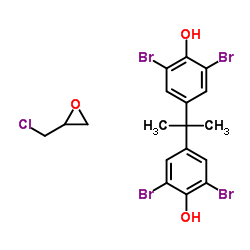Bisphenol A diglycidyl ether, brominated

Bisphenol A diglycidyl ether, brominated structure
|
Common Name | Bisphenol A diglycidyl ether, brominated | ||
|---|---|---|---|---|
| CAS Number | 40039-93-8 | Molecular Weight | 636.395 | |
| Density | N/A | Boiling Point | N/A | |
| Molecular Formula | C18H17Br4ClO3 | Melting Point | 55-65°C (lit.) | |
| MSDS | Chinese USA | Flash Point | 113 °C - closed cup (lit.) | |
| Symbol |

GHS07 |
Signal Word | Warning | |
|
Optimization of a histopathological biomarker for sphingomyelin accumulation in acid sphingomyelinase deficiency.
J. Histochem. Cytochem. 60(8) , 620-9, (2012) Niemann-Pick disease (types A and B), or acid sphingomyelinase deficiency, is an inherited deficiency of acid sphingomyelinase, resulting in intralysosomal accumulation of sphingomyelin in cells throughout the body, particularly within those of the reticuloen... |
|
|
Effect of fixation and embedding on Raman spectroscopic analysis of bone tissue.
Calcif. Tissue Int. 78(6) , 363-71, (2006) Raman spectroscopy provides valuable information on the physicochemical properties of hard tissues. While the technique can analyze tissues in their native state, analysis of fixed, embedded, and sectioned specimens may be necessary on certain occasions. The ... |
|
|
Epoxy resin as fixative during freeze-substitution.
J. Struct. Biol. 152(2) , 92-103, (2005) An alternative protocol for freeze-substitution is described. Araldite/Epon embedding medium (20% in acetone) is first used as a stabilizer (as e.g., OsO(4)) and then as embedding medium. The major components of the Araldite/Epon resin formulation react with ... |
|
|
The role of a new liquid-solid scintillator, a mixture of DPO, POPOP and Epon 812, for enhancement of autoradiograms with tritium agents.
J. Vet. Med. Sci. 60(7) , 795-7, (1998) It is desirable to shorten expose time in 3H-autoradiography. We developed a new solid scintillator, a mixture of DPO, POPOP and Epon 812, for whole-body autoradiography. The new scintillator is originally in a sol form, but quickly transforms to a solid homo... |
|
|
Platinum blue as an alternative to uranyl acetate for staining in transmission electron microscopy.
Arch. Histol. Cytol. 70(1) , 43-9, (2007) This paper introduces an aqueous solution of platinum blue (Pt-blue) as an alternative to uranyl acetate (UA) for staining in transmission electron microscopy (TEM). Pt-blue was prepared from a reaction of cis-dichlorodiamine-platinum (II) (cis-platin) with t... |
|
|
Tissue characteristics of root resorption areas in transplanted maxillary canines.
Acta Odontol. Scand. 55(4) , 206-11, (1997) The aim of the present study was to describe some histopathologic features of tissues collected from root resorption areas of maxillary canines after transalveolar transplantation surgery. In 8 of 101 transplanted canines, complications including cervical roo... |
|
|
High-pressure freezing and freeze-substitution of native rat brain: suitability for preservation and immunoelectron microscopic localization of myelin glycolipids.
J. Neurosci. Res. 53(4) , 465-74, (1998) Galactocerebroside (GalC) and sulfatide are major constituent lipids in vertebrate myelin. Their precise immunolocalization in electron microscopy so far has been hampered by the fact that lipids are not immobilized by chemical fixation and thus get extracted... |
|
|
Maintenance of new cementum formed during cyclosporin A administration after suspension of the treatment.
J. Periodont. Res. 32(7) , 614-8, (1997) The aim of the present investigation was to examine if new cementum (NC) formed during cyclosporin A (CsA) administration was maintained after suspension of the treatment. Thirty mg/kg/d of CsA were given to 3 male Sprague-Dawley rats. Three control rats rece... |
|
|
Diabetes affects statherin expression in human labial glands.
Oral Dis. 17(7) , 685-9, (2011) Salivary statherin, which plays a special role in the defense of tooth integrity, is secreted by both major and minor salivary glands. A significantly reduced expression of this was recently found in human major salivary glands removed from diabetic subjects ... |
|
|
A practical technique to postfix nanogold-immunolabeled specimens with osmium and to embed them in Epon for electron microscopy.
J. Histochem. Cytochem. 48(4) , 493-8, (2000) Nanogold is a tiny gold probe, freely diffusible in cells and tissues, and is suitable for pre-embedding immunohistochemistry. However, it is necessary to develop Nanogold to a larger size so that it can be observed by conventional transmission electron micro... |